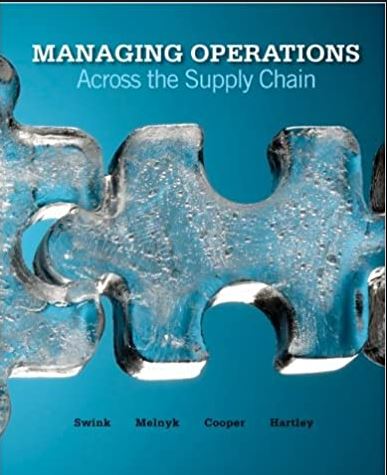
Managing Operations Across the Supply Chain 1st Edition by Morgan Swink,Steven Melnyk,Bixby Cooper, Janet Hartley
Edition 1ISBN: 978-0077426903
Managing Operations Across the Supply Chain 1st Edition by Morgan Swink,Steven Melnyk,Bixby Cooper, Janet Hartley
Edition 1ISBN: 978-0077426903 Exercise 8
Suppose management of Foods Galore (in the first solved problem above)found that it had drastically underestimated its annual inventory carrying cost.Rather than the 10 percent carrying cost assumed in the solved problem, carrying cost is actually 25 percent.Rework all parts of the solved problem assuming the 25 percent carrying cost.
(In Reference First Solved Problem)
Foods Galore is a major distributor to restaurants and other institutional food users.
a.Foods Galore buys cereal from a manufacturer for $20.00 per case.Annual demand for cereal is 200,000 cases, and the company believes that the demand is constant at 800 cases per day for each of the 250 days per year that it is open for business.Average lead time from the supplier for replenishment orders is eight days, and the company believes that it is also constant.The purchasing agent at Foods Galore believes that annual inventory carrying cost is 10 percent and that it costs $40.00 to prepare, send, and receive an order.How many cases of cereal should Foods Galore order each time it places an order? What will be the average inventory? What will be the inventory turnover rate?
b.Foods Galore conducts an in-depth analysis of its inventory management practices and discovers several flaws in its previous approach.First, they find that by ordering 10,000 or more cases each time, they can obtain a price of $18.00 per case from the supplier.What order quantity should Foods Galore place? Why?
c.In its analysis, Foods Galore determined that demand and lead time are not constant.In fact, demand has a standard deviation of 60 cases per day and lead time has a standard deviation of 1.5 days.Foods Galore management wants to evaluate two service level policies.One policy would incur a 5 percent risk of stockout while waiting for replenishment, the other only a 1 percent risk of stockout.What would be the cost of carrying the safety stocks for each of the two policies?
(In Reference First Solved Problem)
Foods Galore is a major distributor to restaurants and other institutional food users.
a.Foods Galore buys cereal from a manufacturer for $20.00 per case.Annual demand for cereal is 200,000 cases, and the company believes that the demand is constant at 800 cases per day for each of the 250 days per year that it is open for business.Average lead time from the supplier for replenishment orders is eight days, and the company believes that it is also constant.The purchasing agent at Foods Galore believes that annual inventory carrying cost is 10 percent and that it costs $40.00 to prepare, send, and receive an order.How many cases of cereal should Foods Galore order each time it places an order? What will be the average inventory? What will be the inventory turnover rate?
b.Foods Galore conducts an in-depth analysis of its inventory management practices and discovers several flaws in its previous approach.First, they find that by ordering 10,000 or more cases each time, they can obtain a price of $18.00 per case from the supplier.What order quantity should Foods Galore place? Why?
c.In its analysis, Foods Galore determined that demand and lead time are not constant.In fact, demand has a standard deviation of 60 cases per day and lead time has a standard deviation of 1.5 days.Foods Galore management wants to evaluate two service level policies.One policy would incur a 5 percent risk of stockout while waiting for replenishment, the other only a 1 percent risk of stockout.What would be the cost of carrying the safety stocks for each of the two policies?
Explanation
Inventory management refers to the manag...
Managing Operations Across the Supply Chain 1st Edition by Morgan Swink,Steven Melnyk,Bixby Cooper, Janet Hartley
Why don’t you like this exercise?
Other Minimum 8 character and maximum 255 character
Character 255


